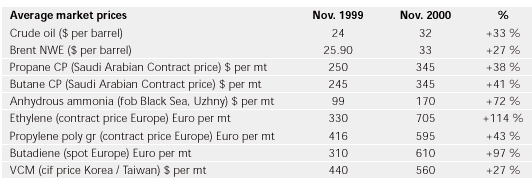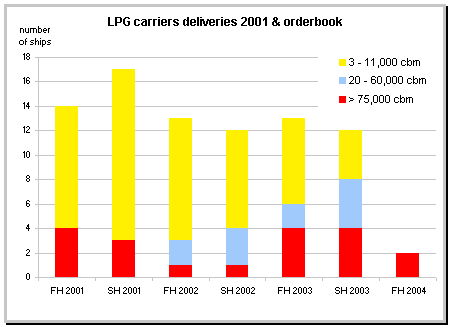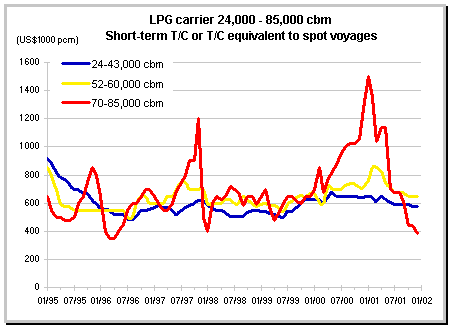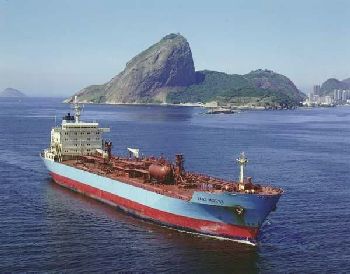
| |
| Significant
events |
|
|
Whereas the year 2000 saw a strong increase in the
price of oil products including LPG and derivatives, and a substantial rise in
freight rates in all segments of the shipping market, we thought that the gas
sector, not having encountered the same upward thrust in rates as other
categories, would somehow behave in a more stable manner and be less affected
by a possible market downturn. We were too optimistic! What is the situation
now at this year-end, when many certainties and expectations have been
shattered, or even dramatically swept aside?
Globally the year 2001 has been marked by a strong slowing down in all
industrial sectors, either upstream in terms of raw materials or downstream in
the demand of by products and their distribution, with as a natural consequence
a strong impact on the freight element.
We should take a look at last year's tables illustrating the price
variations of several key products and up date them for the past twelve months
period:
|

|
...and
another look at the levels of the average freight rates achieved on the
spot market and the equivalent time charter rates for short periods in the
various size categories of ships. We must however remember that these
average rates exclude any eventual idle time between voyages and any
transactions for longer periods (two to five years).

Those negative variations are impressive, as much in the price of
products as for the freight rates, regardless of ship size.
We can summarise the main reasons as follows:
' The world economy has been running out of breath with all signals
going from amber to red, principally in the U.S. which has been the
driving force and where a slow-down in consumption was to be feared for
quite a time after the easy days of the last few years. Unfortunately the
turnaround had to come sooner or later and though everyone tried to cling
on to a few sectors which were still on the boil, the decline had already
set in as from the beginning 2001. OECD statistics for the 30 member
states published successive GDP growth figures each lower than the
preceding, to end up with a level near 1 % for the year, and forecasts
wildly dispersed for 2002 given the actual recession in the U.S. and in
Asia, where levels have now gone into the red. We are a long way from a
level of over 3 % which was predicted at the end of 2000, and the tragic
events of 11th September only accelerated the trend which was already well
established, if often ignored.
' A general surplus capacity of production in all industrial sectors,
whilst demand was weakening. Even though the old adage "more tons
equals more freight" is often true, too big an imbalance between the
development in production and the consumption level can undermine a solid
basis of economic exchanges. One thereby exceeds the limits of practical
hedging between different geographical zones such as have been frequently
developed in the product market. Crude oil, naphtha, LPG, chemical gas and
ammonia have all been hit by such restrictions.
' The limits and consequences of mergers among operators: although
the majority of ships in the LPG fleet above 8,000 cbm is split and run by
the three 'Major' owners, Bergesen, A.P. Moller and Exmar the effect
of freight optimisation on certain movements hits a barrier when a
substantial reduction in traffic comes up. The addition of idle times no
longer allows a pool operator to obtain the appropriate average return on
his fleet, whereas a smaller size operator does not suffer from this same
handicap. The "Major" owner Bergesen decided to change his
policy and approach towards the spot market partly for these reasons but
this did not stop the very low demand conditions reflected in 10 units of
his VLGC pool (75,000 / 85,000 cbm) currently looking for employment in
the Middle East. Although difficult to quantify, the mergers and groupings
realised over recent years in the product side have become operational and
have now allowed a full optimisation of logistics in several markets which
previously were more competitive but less efficient, with inevitable
consequences in the volumes exchanged.
' Delivery of newbuildings ordered since 1998: within a market with
limited growth, deliveries of new units create exponential availability of
capacity. At the end of November, there have been 28 newbuildings
delivered since January 1st 2001, with capacities ranging from 1,000 cbm
to 84,000 cbm for a total of 578,000 cbm! It should be said however that
six VLGCs (78,000 / 84,000 cbm) are included in these deliveries.
|

|
| Situation
by ship size |
|
|
- VLGC (very large gas carriers): 70,000
to 86,000 cbm
|
|

|
The year 2001 witnessed a wild fluctuation in this sector, still
fragile and highly exposed to the structure of "contract
prices" compared to spot prices of butane and propane. Despite a
strong rise starting in mid 2000 with the help of the clean product
market (naphtha and jet) which led to nearly record historic highs at
the beginning of the year at levels of $50 per ton for voyages MEG /
Japan - an equivalent monthly time charter rate of roughly $1.6
million - a sharp drop was experienced already as from February.
The pressure of American imports was no longer felt and the clean
product options diminished whilst opportunities for LPG employment
became more scarce.
The proportion of the fleet employed in the clean product market in
January 2001 went from twelve ships down to five or six at the end of
the summer and back to eight at the end of November, despite a lower
income return. Although not being as firm as at the start of the year,
this market still offers freight levels above those in LPG, namely an
equivalent monthly time charter rate of about $450,000 as against below
$300,000 for LPG, also affecting the percentage of idle time to 8 % in
October 2001.
A limited number of time charter transactions have recently been
concluded on the basis of three to 12 months, well below previous
levels, in the order of $450,000 / 475,000 monthly.
There is a serious question mark hanging over this segment of
tonnage, supplemented by a further 13 units under construction which are
due to be delivered in the next two years, mainly for the account of
Japanese and Korean conglomerates, one oil Major operator already tied
up with the Bergesen pool, and a few independent owners. Seven of these
ships have been delivered during the course of 2001, thus representing a
large additional cbm capacity within an already depressed market.
|
|
|
|
The drop in activity in this size category was not as important as
that affecting the VLGCs. This smaller segment accounts for 27 ships
being spread between two distinct product markets, ammonia and LPG, of
which 22 are controlled by Bergesen.
We were already questioning this issue in our previous reports and we
now see this sector has registered four new units ordered for delivery
in 2003, a fairly inevitable step in an attempt to improve the average
age of this fleet: 14 of them are still over 20 years.
The monthly returns of these ships have substantially fluctuated over
the last twelve months following the variations on imports of ammonia
and LPG into the U.S., with a pronounced dip in the last quarter, and
currently achieve on the spot market about $675,000 monthly, always
excluding all idle time between voyages.
A certain stability and therefore less volatility can be expected in
this sector over the next few years with the prospect of a few old units
being withdrawn from the market.
|
|
|
|
|
Amongst the different sizes of ships, this
segment is nearly exclusively controlled by Exmar following the big
reshuffling by sizes which gradually took place over the last few years,
and turned out to be the one least affected by the downturn in the market.
The concentration of such a fleet of more than 25 ships, combined with the
flexibility of switching from ammonia to LPG and vice versa, means that
the rates concluded varied little both on term business as well as spot.
However the idle time for this fleet, roughly 15 % for the first nine
months of 2001, has considerably increased in the last two months to close
to 22 %. Certain trades like the imports of ammonia into the United-States
have been severely affected by the sudden plunge in the price of natural
gas. While the time charter rates for a period of one to three years fall
within a monthly bracket of $475,000 / 575,000 for a 24,000 cbm and of
$670,000 / 750,000 for a 35,000 / 39,000 cbm, voyage rates achieve the
same levels on time charter equivalent basis and sometimes even more when
employed in the ammonia business. Nonetheless the sector is vulnerable
given that they can face competition in the spot market from both the
larger and the smaller sizes. Four new units of 35,000 / 37,000 cbm are
currently on order for the account of Bibby, Mitsui, Geogas, and Carbofin,
for delivery end 2002 and 2003, but the latter ones should not have too
bad an effect on the evolution of this sector, given that several units
are due to be withdrawn in the next few years on account of their age.
|
 |
Jane Maersk
35,639 cbm, blt 1990 by Hyundai, operated by Exmar and time-chartered by Petrobras |
|
Shipping and Shipbuilding Markets in 2001
I N D E X
|